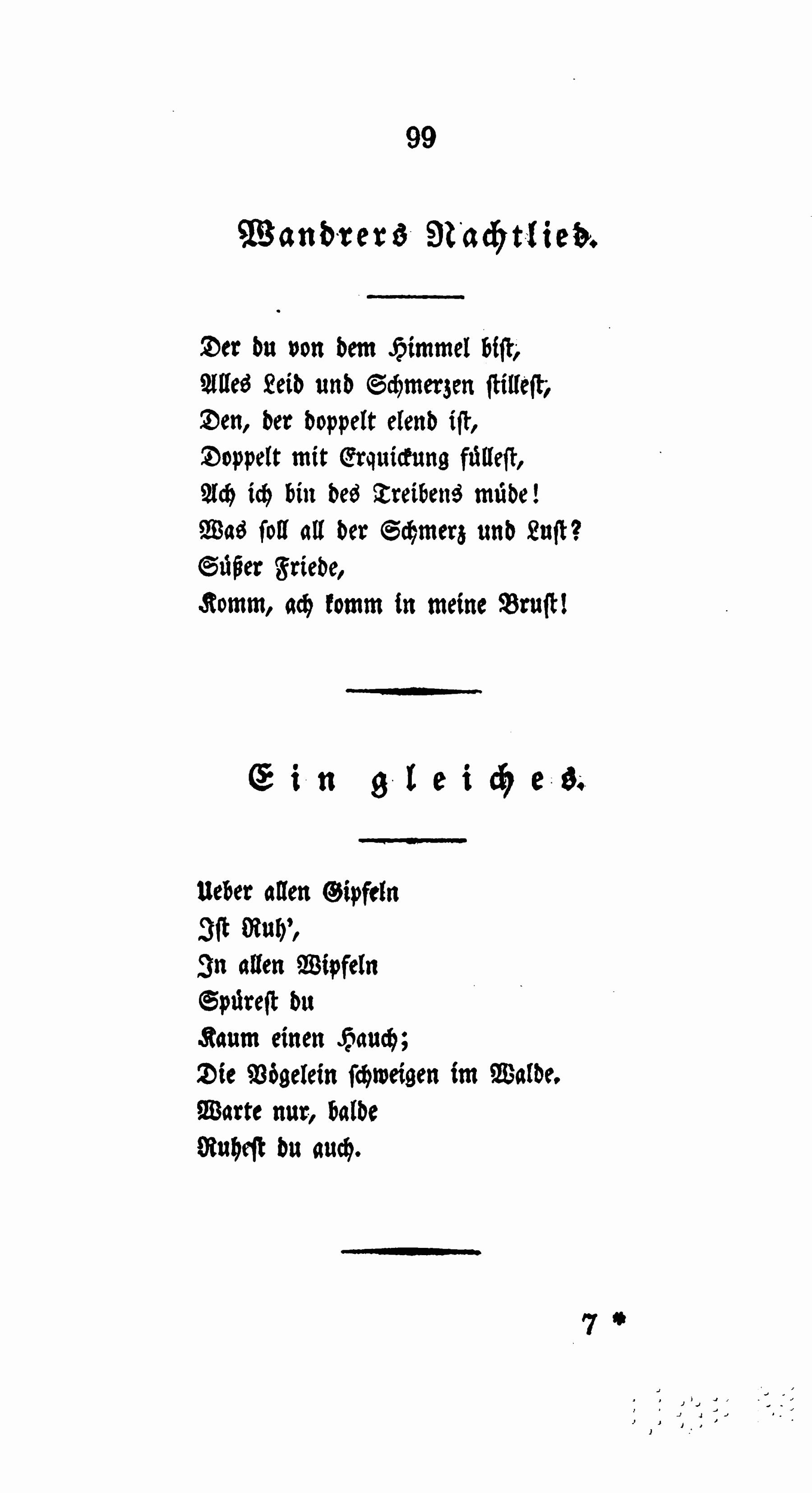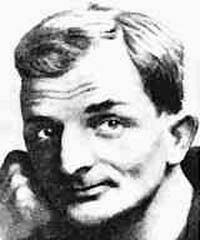|
Wandrers Nachtlied
"Wanderer's Nightsong" (original German title: "") is the title of two poems by the German poet Johann Wolfgang von Goethe. Written in 1776 ("") and in 1780 (""), they are among Goethe's most famous works. Both were first edited together in his 1815 ''Works'' Vol. I with the headings "" and "" ("Another one"). Both works were set to music as lieder by Franz Schubert and catalogued as D 224 and D 768. Wanderer's Nightsong I The manuscript of "Wanderer's Nightsong" ("") was among Goethe's letters to his friend Charlotte von Stein and bears the signature "At the slope of Ettersberg, on 12 Feb. 76"; supposedly it was written under the tree later called the Goethe Oak. One translation is by Henry Wadsworth Longfellow: Franz Schubert set the poem to music in 1815 (as No.3 in his Op.4, D.224), changing "stillest" and "füllest" to "stillst" and "füllst," and, more significantly, "Erquickung" (refreshment) to "Entzückung" (delight). Wanderer's Nightsong II Wanderer's Ni ... [...More Info...] [...Related Items...] OR: [Wikipedia] [Google] [Baidu] |
Luise Von Göchhausen
Louise Ernestine Christiane Juliane von Göchhausen (13 February 1752 – 7 September 1807) was Chief Lady-in-Waiting to Duchess Anna Amalia of Saxe-Weimar-Eisenach. Known for her sharp wit, she became a close friend of Johann Wolfgang von Goethe. Life Born in Eisenach, the daughter of a Saxe-Weimar official, Luise von Göchhausen was small and hunchbacked in stature; therefore, she considered herself lucky to be accommodated as a Lady-in-Waiting, initially to Margravine Caroline Louise of Baden, from 1783 at the Weimar court, where she and Anna Amalia lived at Tiefurt House. Appreciated by the duchess for her intelligence and wisdom, Göchhausen also developed a good relationship with Goethe, who had been appointed to the court by Anna Amalia's son, the young Duke Karl August. She prepared numerous transcripts and excerpts of Goethe's works, among them several scenes from ''Faust'' the poet had written between 1772 and 1775. The manuscript of this earliest form of the work, kn ... [...More Info...] [...Related Items...] OR: [Wikipedia] [Google] [Baidu] |
Radio Drama
Radio drama (or audio drama, audio play, radio play, radio theatre, or audio theatre) is a dramatized, purely acoustic performance. With no visual component, radio drama depends on dialogue, music and sound effects to help the listener imagine the characters and story: "It is auditory in the physical dimension but equally powerful as a visual force in the psychological dimension." Radio drama includes plays specifically written for radio, docudrama, dramatized works of fiction, as well as plays originally written for the theatre, including musical theatre, and opera. Radio drama achieved widespread popularity within a decade of its initial development in the 1920s. By the 1940s, it was a leading international popular entertainment. With the advent of television in the 1950s radio drama began losing its audience. However, it remains popular in much of the world. Recordings of OTR ( old-time radio) survive today in the audio archives of collectors, libraries and museums, as well ... [...More Info...] [...Related Items...] OR: [Wikipedia] [Google] [Baidu] |
Computational Linguistics
Computational linguistics is an Interdisciplinarity, interdisciplinary field concerned with the computational modelling of natural language, as well as the study of appropriate computational approaches to linguistic questions. In general, computational linguistics draws upon linguistics, computer science, artificial intelligence, mathematics, logic, philosophy, cognitive science, cognitive psychology, psycholinguistics, anthropology and neuroscience, among others. Sub-fields and related areas Traditionally, computational linguistics emerged as an area of artificial intelligence performed by computer scientists who had specialized in the application of computers to the processing of a natural language. With the formation of the Association for Computational Linguistics (ACL) and the establishment of independent conference series, the field consolidated during the 1970s and 1980s. The Association for Computational Linguistics defines computational linguistics as: The term "comp ... [...More Info...] [...Related Items...] OR: [Wikipedia] [Google] [Baidu] |
Bertolt Brecht
Eugen Berthold Friedrich Brecht (10 February 1898 – 14 August 1956), known professionally as Bertolt Brecht, was a German theatre practitioner, playwright, and poet. Coming of age during the Weimar Republic, he had his first successes as a playwright in Munich and moved to Berlin in 1924, where he wrote ''The Threepenny Opera'' with Kurt Weill and began a life-long collaboration with the composer Hanns Eisler. Immersed in Marxist thought during this period, he wrote didactic ''Lehrstücke'' and became a leading theoretician of epic theatre (which he later preferred to call "dialectical theatre") and the . During the Nazi Germany period, Brecht fled his home country, first to Scandinavia, and during World War II to the United States, where he was surveilled by the FBI. After the war he was subpoenaed by the House Un-American Activities Committee. Returning to East Berlin after the war, he established the theatre company Berliner Ensemble with his wife and long-time collaborator ... [...More Info...] [...Related Items...] OR: [Wikipedia] [Google] [Baidu] |
The Last Days Of Mankind
''The Last Days of Mankind'' (german: Die letzten Tage der Menschheit) is a satirical play by Karl Kraus. It is considered one of the most important of Kraus's works. One third of the play is drawn from documentary sources and is highly realistic, except the final scenes which are of expressionist genre.Knight, Charles A. (2004) Literature of Satire p.255 Notes and references Further reading''"Die letzten Tage der Menschheit" im Bunker'' Spiegel Online, April 22, 1999 * External links Hanns Eisler in German at Project Gutenberg
Project Gutenberg (PG) is a Virtual volunteering, volunteer effort to digitize and archive cultural works, as well as to "encourage the creation and distribution of eBoo ...
[...More Info...] [...Related Items...] OR: [Wikipedia] [Google] [Baidu] |
Karl Kraus (writer)
Karl Kraus (28 April 1874 – 12 June 1936) was an Austrian writer and journalist, known as a satirist, essayist, aphorist, playwright and poet. He directed his satire at the press, German culture, and German and Austrian politics. He was nominated for the Nobel Prize in Literature three times. Biography Early life Kraus was born into the wealthy Jewish family of Jacob Kraus, a papermaker, and his wife Ernestine, née Kantor, in Jičín, Kingdom of Bohemia, Austria-Hungary (now the Czech Republic). The family moved to Vienna in 1877. His mother died in 1891. Kraus enrolled as a law student at the University of Vienna in 1892. Beginning in April of the same year, he began contributing to the paper , starting with a critique of Gerhart Hauptmann's ''The Weavers''. Around that time, he unsuccessfully tried to perform as an actor in a small theater. In 1894, he changed his field of studies to philosophy and German literature. He discontinued his studies in 1896. His friendship with P ... [...More Info...] [...Related Items...] OR: [Wikipedia] [Google] [Baidu] |
Joachim Ringelnatz
Joachim Ringelnatz is the pen name of the German author and painter Hans Bötticher (7 August 1883, Wurzen, Saxony – 17 November 1934, Berlin). His pen name ''Ringelnatz'' is usually explained as a dialect expression for an animal, possibly a variant of ''Ringelnatter'', German for grass snake or more probably the seahorse for winding ("ringeln") its tail around objects. The seahorse is called Ringelnass (nass = wet) by mariners, an occupation to which he felt kinship. He was a sailor in his youth and spent the First World War in the Navy on a minesweeper. In the 1920s and 1930s, he worked as a ''Kabarettist'', i.e., a kind of satirical stand-up comedian. He is best known for his wry poems using word play and sometimes bordering on nonsense poetry. Some of them are similar to Christian Morgenstern's, but more satirical in tone and occasionally subversive. His most popular character is the anarchic sailor ''Kuddel Daddeldu'' with his drunken antics and disdain for authority. ... [...More Info...] [...Related Items...] OR: [Wikipedia] [Google] [Baidu] |
Christian Morgenstern
Christian Otto Josef Wolfgang Morgenstern (6 May 1871 – 31 March 1914) was a German author and poet from Munich. Morgenstern married Margareta Gosebruch von Liechtenstern on 7 March 1910. He worked for a while as a journalist in Berlin, but spent much of his life traveling through Germany, Switzerland, and Italy, primarily in a vain attempt to recover his health. His travels, though they failed to restore him to health, allowed him to meet many of the foremost literary and philosophical figures of his time in central Europe. Morgenstern's poetry, much of which was inspired by English literary nonsense, is immensely popular, even though he enjoyed very little success during his lifetime. He made fun of scholasticism, e.g. literary criticism in "Drei Hasen", grammar in "Der Werwolf", narrow-mindedness in "Der Gaul", and symbolism in "Der Wasseresel". In "Scholastikerprobleme" he discussed how many angels could sit on a needle. Still many Germans know some of his poems ... [...More Info...] [...Related Items...] OR: [Wikipedia] [Google] [Baidu] |
Carl Friedrich Zelter
Carl Friedrich Zelter (11 December 1758 15 May 1832)Grove/Fuller-Datei:Carl-Friedrich-Zelter.jpegMaitland, 1910. The Zelter entry takes up parts of pages 593-595 of Volume V. was a German composer, conductor and teacher of music. Working in his father's bricklaying business, Zelter attained mastership in that profession, and was a musical autodidact. Zelter was born and died in Berlin. He became friendly with Johann Wolfgang von Goethe, and his works include settings of Goethe's poems. During his career, he composed about two hundred lieder, as well as cantatas, a viola concerto (performed as early as 1779) and piano music. Amongst Zelter's pupils (at different times) were Felix Mendelssohn, Fanny Mendelssohn, Giacomo Meyerbeer, Eduard Grell, Otto Nicolai, Johann Friedrich Naue, and Heinrich Dorn. Felix Mendelssohn was perhaps Zelter's favorite pupil and Zelter wrote to Goethe boasting of the 12-year old's abilities. Zelter communicated his strong love of the music of J. S. B ... [...More Info...] [...Related Items...] OR: [Wikipedia] [Google] [Baidu] |

_-_Luise_von_Göchhausen.jpg)


_1988%2C_MiNr_Block_091.jpg)
_Cover.jpg)

